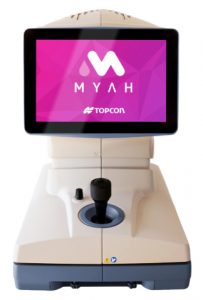CAPELLE A/D IJSSEL, Netherlands – Topcon Healthcare, a leading provider of medical devices and software solutions for the global eye care community, announced today that it has launched its new MYAH instrument to the European region. MYAH is a comprehensive management tool for eyecare professionals interested in building, managing and growing myopia and dry eye services within their practice or research institution.

The versatile, all-in-one MYAH provides all the critical tools needed to support myopia management while also offering an evolving platform to add or grow dry eye management. MYAH incorporates corneal topography including keratoconus screening and pupillometry, axial length measurements by optical low coherence interferometry, progression reports for analyzing treatment efficacy, and a comprehensive suite of dry eye assessment tools. The instrument is compact, easy to operate, and offers rapid capture to ensure patient satisfaction.
With the launch of MYAH, Topcon achieves a milestone in the battle against the global myopia epidemic. It is estimated that 50% of the world’s population, including European regions, may be myopic by 20501.
“MYAH is ideally suited to combat the growing crises of both myopia and dry eye disease. Its versatility and ease of use allows eyecare professionals to easily build a myopia service within their practice, educate patients on the implications of myopia and dry eye disease, manage their patients’ conditions, and grow their service offerings,” stated John Trefethen, Global VP of Marketing & Product Design for Topcon Healthcare.
For more information on MYAH, please visit www.topconmyah.com.
About Topcon Healthcare
Topcon Healthcare sees eye health differently. Our vision is to empower providers with smart and efficient technologies for enhanced patient care. Keeping pace with the ever-changing landscape of the healthcare industry, we offer the latest integrated solutions including advanced multimodal imaging, vendor-neutral data management and ground-breaking remote diagnostic technology.
A globally-oriented business, Topcon is focused on developing solutions towards solving societal challenges in the mega-domains of healthcare, agriculture, and infrastructure. In healthcare, these challenges include increasing eye disease, rising medical costs, access to healthcare and physician shortages. By investing in value-driven innovations, Topcon works to enable people to enjoy good health and a high quality of life.